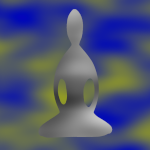Dear Friends,
“The eyes see; the ears hear; the mind thinks.”
I have heard many meditation teachers give a statement similar to the above. In the same way we don’t expect hearing to stop just because we are meditating, we also should not expect thinking to stop.
That said, we can learn to relate to the thoughts in a different way, and meditation is one way to build these skills.
Mindfulness practice isn’t meant to eliminate thinking but rather to help us know what we’re thinking when we’re thinking it, just as we want to know what we’re feeling when we’re feeling it.
Mindfulness allows us to watch our thoughts, see how one thought leads to the next, decide if we’re heading down an unhealthy path, and, if so, let go and change directions. It allows us to see that who we are is much more than a fearful or envious or angry thought. We can rest in the awareness of the thought, in the compassion we extend to ourselves if the thought makes us uncomfortable, and in the balance and good sense we summon as we decide whether and how to act on the thought.
Sharon Salzberg, Real Happiness: The Power of Meditation: A 28-Day Program, week three
Thinking is a natural and useful process. There is a necessary amount of thinking required to plan, to create, to evaluate, to make sense of things. The challenge is we often get lost in thoughts, ruminating over and over the same few things, or proliferating one thought into a bunch of thoughts.
I remember how Susie Harrington explained this on the last full day of a retreat, where the next day we would have to wake early, pack our tents, and hike quite a ways to get back to our cars. She recognized a certain amount of planning and thinking is necessary in this case, but she invited us to notice how much was actually necessary.
I could see there were certain useful planning thoughts – this evening, pack the clothes I won’t be wearing, and put out the clothes I would be wearing. And then I could see how other thoughts would tag on to those basics, and suddenly, I would be thinking about getting to the car, and what if the car didn’t start, or what if it was stolen while I was on retreat, and how would I get home… could I rent a car? Okay… those were not very useful planning thoughts.
Planning and worrying thoughts are some common themes I notice in meditation. I also have the narrator (the kind of thought that says “Andrea is feeling her breath” rather than actually experiencing breathing), the undecider (should I attend to the breath or the body, oh maybe let’s do sounds), and the judge (this meditation isn’t as good as the last one) – and others, of course.
Diana Winston suggests an exercise to identify your “top ten” (or even five) thought patterns:
Begin by identifying your top ten troublesome thoughts. What kinds of thoughts drive you crazy? The answer may be immediately obvious to you (worry, for example), or it may take a little self-observation. If you are not sure, during the course of the coming week try to notice the recurring thoughts you have that cause you discomfort or pain. The next time you are feeling bad (anxious, upset, angry), try to identify the thoughts that brought you to this state of mind.
Susan L. Smalley, PhD and Diana Winston, Fully Present: The Science, Art, and Practice of Meditation, page 183
I find this useful because it can help me notice these patterns a little more quickly, and maybe disengage from them a bit sooner. (Oh, the narrator! Let’s actually feel the breathing instead!)
What are some of your thought patterns? Feel free to share here or by email.
Thoughtfully yours,
Andrea

There are some things we think and some things we know. Recognizing the difference seems to me one of the most useful recognitions for a worrier like me.
Loved the way you signed off today’s meditation—a deft combination of apt reference to the theme of the meditation and wit!
That’s an interesting distinction between the things we think and the things we know. Thanks for adding that!
This post really hit home for me. As a self-professed proficient planner, I’m often 6 steps ahead of what’s actually necessary, just I’ve never thought of it that way!
The “what if the car is stolen” made me actually laugh out loud because I could absolutely see myself having the same thought and it was humorous to recognize how, almost, irrelevant it is in the moment.
Also, the idea of “the narrator” resonated. I was noticing the other day how there was a steady stream of words in my head, constantly. So many words! And then I noticed that it could lead to a feeling of overwhelm for me. A quick sit or walk were helpful in the moment. Any other advice for working with the narrator?
One thing I try with the narrator is to remember my intention. Why am I meditating? Then if the narrator is not contributing to that, I can repeat a phrase I learned from Adrianne Ross: “Not now. Here.”
I can also drop into the body sensations rather than the narrator’s story of the sensations. (You might have noticed that sometimes the narrator is saying “inhale” when it’s actually an exhale, or things like that…)
I’m sure you can think of other approaches too. See what works for you and let me know!